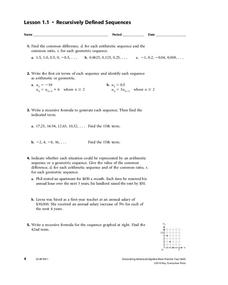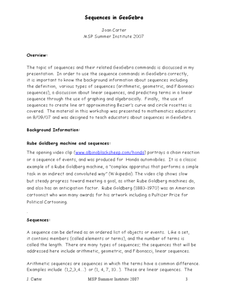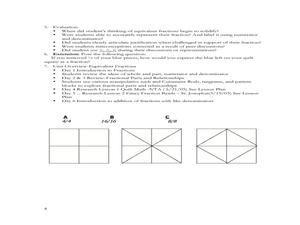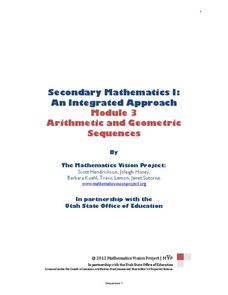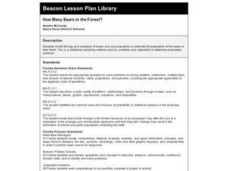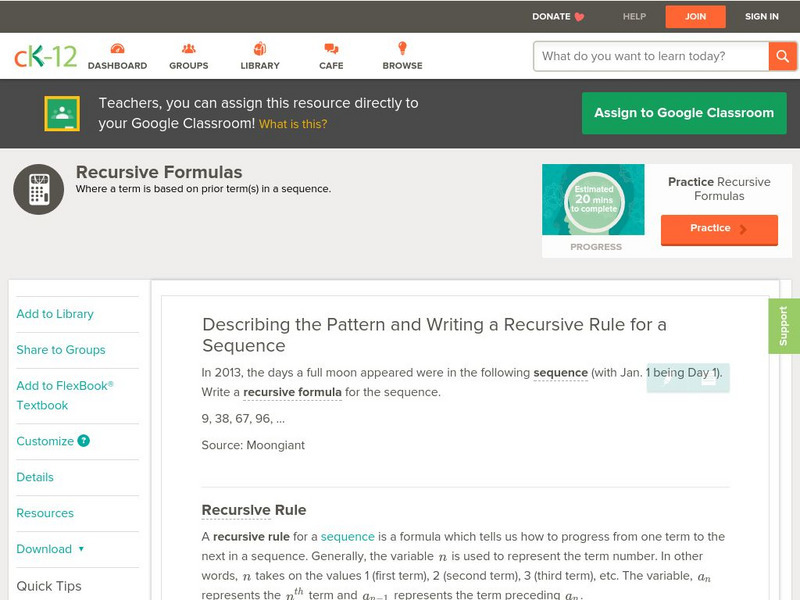Cornell University
Splitting Water with Electricity
Explore how electricity splits water molecules into hydrogen and oxygen. Learners begin by calculating the voltage necessary to separate the water. They then perform the experiment and measure the ratio of hydrogen and oxygen bubbles.
Curated OER
Fraction and Decimal Ordering
Ordering numbers just got physical! Learners practice putting numbers in sequence, both in fraction and decimal form. To begin, they line up in birthday order and discuss the difference between ascending and descending. They are then...
Curated OER
Applications, Proportions, and Problem Solving
In this math worksheet, students find the solutions to the problems involving proportions. They also compare the similar triangles.
West Contra Costa Unified School District
Connecting Fractions and Rational Expressions
Teach class members to work with rational expressions using their knowledge of fractions. The lesson plan starts with a warm-up of rational expressions at four different levels of complexity. The different levels continue throughout...
Curated OER
How Stuff Is Put Together (Chemical Bonding)
Fourth graders participate in a simple experiment that shows the ratio of elements that make up water.
Curated OER
Stock Swaps, Variation 3
More on the fictitious takeover of the Apple Corporation by Microsoft. In this scenario, Microsoft has $28.00 per share to spare, so how many do they need to offer to make an even trade? This is an engaging problem to solve when...
Curated OER
Take A Chance Or Two
A two-part lesson immerses young statisticians in the concept of probability. On the first day, will conduct experiments with a two-colored coin and learn how to write probabilities as fractions, ratios, and percentages. In the second...
Curated OER
Computer Skills for the Classroom and Beyond
Students discover the concept of telecomputing. They identify the ways it promotes a global community. They exchange e-mails with students in other countries. They also examine the difference between public and private information.
Willow Tree
Arithmetic and Geometric Sequences
Old mathematicians never die; they just lose some of their functions. Studying sequences gives scholars an opportunity to use a new notation. Learners write functions to model arithmetic and geometric sequences and use them to find new...
EngageNY
Percent Rate of Change
If mathematicians know the secret to compound interest, why aren't more of them rich? Young mathematicians explore compound interest with exponential functions in the twenty-seventh installment of a 35-part module. They calculate future...
Virginia Department of Education
Relationships Round Robin
Mathematics is all about patterns. Young mathematicians analyze geometric patterns to write algebraic expressions. They use the expressions to predict future stages of the patterns.
Curated OER
Recursively Defined Sequesnces
In this algebra instructional activity, students solve a pattern or sequence using geometric and arithmetic formulas. There are 21 questions on 5 different sections.
Curated OER
Sequences in Geogebra
Students follow detailed directions to use the GeoGebra program. In this mathematics lesson, students find the nth term of a sequence, and use line art to approximate a Bezier's curve. Students locate points and segments on a circle. The...
Curated OER
Half Math Quilt
Help your third graders become familiar with equivalent fractions for one-half by having them create a quilt. They will use triangles to create a quilt of equivalent fractions over a period of 6 days. As they create the quilt pieces they...
Mathematics Vision Project
Module 3: Arithmetic and Geometric Sequences
Natural human interest in patterns and algebraic study of function notation are linked in this introductory unit on the properties of sequences. Once presented with a pattern or situation, the class works through how to justify...
Exploratorium
Salty Pits
Yuck, does my deodorant kill that? To test whether deodorant is anti-bacterial, class members use petri dishes to grow control bacteria and bacteria from sweat, and then compare them to see if deodorant effects the...
Curated OER
Taste the Rainbow
Middle schoolers practice estimating and graphing by utilizing Skittles. In this statistics lesson plan, students complete worksheets based on the likelihood of a certain color of skittle coming out of the bag. Middle...
Curated OER
Basic Roof Framing
Learners complete a unit of lessons on basic roof framing. They discuss the various styles of roofs, identify the styles in the neighborhood, cut out rafters using circular saws, and assemble roof rafters.
Curated OER
How Many Bears in the Forest?
Third graders model the tag and recapture of bears and use proportions to estimate the population of the bears in their forest. This is a statistical sampling method used by scientists and naturalists to determine population numbers.
Illustrative Mathematics
Illustrative Mathematics: 6.rp Voting for Three, Variation 3
Students use simple ratios to answer the following question: John, Marie, and Will all ran for 6th grade class president. The ratio of votes for John to votes for Will was two to one. Marie got exactly the average number of votes for the...
Learning Wave Communications
Learning Wave: Fractions
This resource contains information about fractions and includes ratios, equivalent fractions, basic operations, and reciprocals. Several links for practice problems are also included, along with links to a post and pretest.
Education Development Center
Tune in to Learning: Understanding Mean, Median and Mode
Have you ever wondered what the difference is with mean, median, and mode? Here are some exercises that will help you understand what each is.
CK-12 Foundation
Ck 12: Analysis: Recursive Formulas
[Free Registration/Login may be required to access all resource tools.] This lesson provides a review of a variety of sequence types including recursive, arithmetic, and geometric. Students examine guided notes, review guided practice,...











